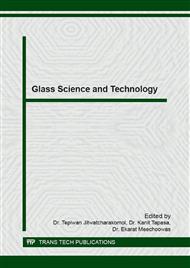[1]
K. Won-in, Y. Thongkam, W. Dhammanonda, J. Dutchaneephet, T. Kamwanna, S. Intarasiri, et al., Characterization on mosaic glass excavated from Phu Khao Thong (Ranong), Thailand, Phys. Procedia 48 (2013) 30 – 37.
DOI: 10.1016/j.phpro.2013.07.006
Google Scholar
[2]
K. Won-in, Y. Thongkam, W. Dhammanonda, J. Dutchaneephet, T. Kamwanna, S. Intarasiri, et al., Characterization on eye glass bead found at Khao Sri Vichai (Surat Thani), Thailand, Phys. Procedia 48 (2013) 23 – 29.
DOI: 10.1016/j.phpro.2013.07.005
Google Scholar
[3]
K. Polikreti, J.M.A. Murphy, V. Kantarelou and A.G. Karydas, XRF analysis of glass beads from the Mycenaean palace of Nestor at Pylos, Peloponnesus, Greece: new insight into the LBA glass trade, J. Archaeol. Sci. 38 (2011) 2889-2896.
DOI: 10.1016/j.jas.2011.05.003
Google Scholar
[4]
M. Verità, A. Renier and S. Zecchin, Chemical analyses of ancient glass findings excavated in the Venetian lagoon, J. Cult. Herit. 3 (2002) 261–271.
DOI: 10.1016/s1296-2074(02)01235-9
Google Scholar
[5]
L. Dussubieux, B. Gratuze and M. Blet-Lemarquand, Mineral soda alumina glass: occurence and meaning. J. Archaeol. Sci. 37 (2010) 1646–1655.
DOI: 10.1016/j.jas.2010.01.025
Google Scholar
[6]
M. Bertini, A. Shortland, K. Milek and E.M. Krupp, Investigation of Iron Age north-eastern Scottish glass beads using element analysis with LA-ICP-MS, J. Archaeol. Sci. 38 (2011) 2750-2766.
DOI: 10.1016/j.jas.2011.06.019
Google Scholar
[7]
J. Lankton and L. Dussubieux, Early Glass in Asian Maritime Trade: A Review and an Interpretation of Compositional Analysis, J. Glass Stud. 48 (2006) 121-144.
Google Scholar
[8]
J. Lankton and L. Dussubieux, Early Glass in Southeast Asia, in: K. Janssens (Eds. ), Modern Methods for Analysing Archaeological and Historic Glass, Wiley and Sons, West Sussex, 2013, pp.413-441.
DOI: 10.1002/9781118314234.ch20
Google Scholar
[9]
Y. Lei and Y. Xia, Study on production techniques and provenance of faience beads excavated in China, J. Archaeol. Sci. 53 (2015) 32-42.
DOI: 10.1016/j.jas.2014.09.019
Google Scholar
[10]
M.B. Toffolo, E. Klein, R. Elbaum, A.J. Aja, D.M. Master and E. Boaretto, An early Iron Age assemblage of faience beads from Ashkelon, Israel: chemical composition and manufacturing process, J. Archaeol. Sci. 40 (2013) 3626-3635.
DOI: 10.1016/j.jas.2013.05.010
Google Scholar
[11]
A. Silvestri, S. Tonietto, F. D'Acapito and G. Molin, The role of copper on colour of palaeo-Christian glass mosaic tesserae: An XAS study, J. Cult. Herit. 13 (2012) 137–144.
DOI: 10.1016/j.culher.2011.08.002
Google Scholar
[12]
A.A. Ahmed, G.M. Ashour and T.M. El-Shamy, Effect of melting conditions on the crystallization of cuprous oxide and copper in glass, Proc. XIth Int. Cong. Glass (Prague) 2 (1977) 177–187.
Google Scholar


